Stony Brook, NY, May 1, 2023
Funding, part of a larger $27M funding effort by NOAA (Sea Grant’s parent organization), supports four projects focusing on ways to reduce plastic and other types of pollution in NYS’s coastal and river waterways
• Three New York Sea Grant (NYSG) teams will receive more than $5.2 million in funding to carry out community action and research activities to reduce plastic and other types of pollution in the state’s coastal and river waterways.
• A fourth partner project, led by New Jersey Sea Grant, will also include funds to support students working in New York with NYSG’s extension specialists.
Projects of the three NYSG-funded teams — each led by principal investigators at universities (Columbia University, Rochester Institute of Technology) and organizations (PolyGone Systems) who will work side-by-side with NYSG extension professionals — will focus on: (1) investigating advanced filtration techniques; (2) removing stray plastics from streams and rivers; (3) installing and studying traps to keep litter from entering storm drains in cities; (4) determining how to keep clothing from releasing threads of plastic into the environment.
“New York Sea Grant is incredibly excited to engage in these powerful new partnerships that will develop and implement cutting edge, innovative, and community-based solutions to address marine plastics and other debris in our waterways - including in New York’s Great Lakes, Hudson River, and New York City,” said Becky Shuford, director of NYSG. “Each team will cooperate with NYSG extension staff to help ensure the results of this impactful work will be accessible to and actionable by communities across New York State and beyond.”
“Land-based sources of debris are impacting our shorelines and beaches, our aquatic life, and our waters,” said Kathy Bunting-Howarth, associate director of NYSG. “Some of this debris is microscopic. These microplastics and microfibers are entering our ecosystems and our bodies and impacting us in ways that we do not fully understand.” With that, Bunting-Howarth adds that these projects will explore ways to prevent debris from entering our waterways, from stormwater and clothes washing, as well as test technologies to capture the debris that’s already escaped into the waters.
Marine Debris Funding: NYSG-Funded Projects
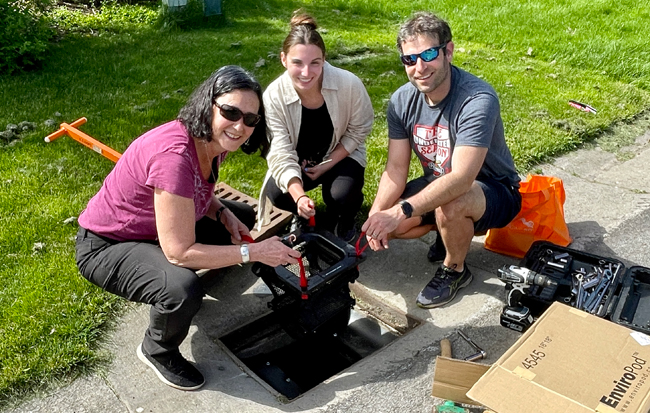
(l-r) RIT’s Christy Tyler (NYSG-funded PI), Paige Arieno (RIT environmental science student), and Matthew Hoffman (RIT professor) install a Littatrap in a storm drain in Brighton. Credit: Brian Quigley
Mitigation of stormwater-derived debris: a community-based approach
• Mary Austerman – NYSG's Great Lakes Coastal Community Development Specialist
• Christy Tyler – Rochester Institute of Technology (RIT)
This project seeks to build a community network focused on preventing and cleaning up debris that gets into the Rochester Embayment of Lake Ontario. Much of this debris is generated by humans and carried by stormwater into the lake. As part of the solution, team members will expand their placements of “Littatraps,” mesh baskets installed in stormwater catch basins. These will be located throughout the City of Rochester and the surrounding area. The project will create opportunities to engage local youth in education, data collection, debris clean up and removal, leadership, and civic action.
“The Rochester Institute of Technology is thrilled to partner with New York Sea Grant to tackle the problem of plastic pollution in the Great Lakes,” said Christy Tyler, an environmental scientist at RIT. “Much of the plastic pollution problem begins in the watershed, and we will be working on the ground in the community to intercept pollution using innovative technologies, collect data to determine the source of the problem, and develop and implement local solutions.”
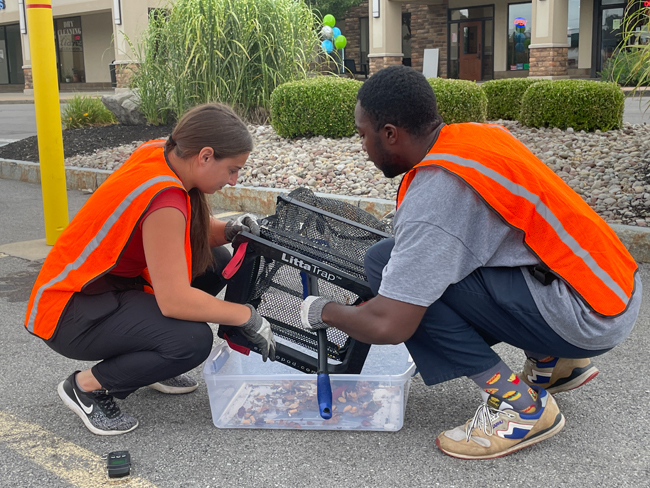
(l-r) Paige Arieno and Evan Batte (RIT environmental science students) collect debris from Littatrap in a storm drain in Brighton. Credit: Christy Tyler
This Rochester project is one of a total of 19 national Community Action Coalition projects across California, Delaware, Hawai'i, Louisiana, Maine, Maryland, Massachusetts, New Jersey, New York, Ohio, Oregon, South Carolina, Virginia, Washington and Wisconsin. They were recommended for approximately $5 million in total funding.
Also included among this set of 19 national projects is a summer K-12 community outreach effort that NYSG is partnering on with the New Jersey Sea Grant Consortium (and Columbia University’s Eco Ambassador program) to develop timely and effective marine debris curricula and expand environmental literacy outreach to school districts from marginalized communities located in New Jersey and New York urban watersheds. Additionally, participants will be trained in community science approaches to collect water, soil and biological samples from their communities for plastic waste analysis.
• Lillit Genovesi –NYSG's Long Island Sound Study Outreach Coordinator, New York City and Westchester County
• Diana Burich – New Jersey Sea Grant Consortium
For more, see the full list of and descriptions for Marine Debris Community Action Coalitions projects.
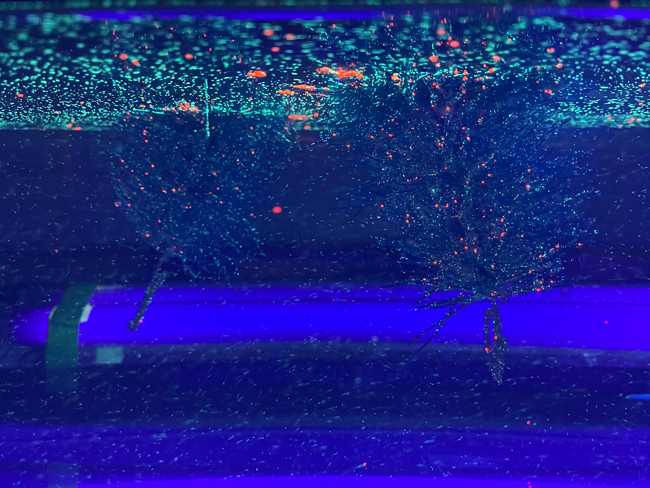
‘Artificial Root’ fiber ball under UV light following flow tank experiments. Fluorescent microplastics remain adhered to the filtration device following removal from the tank. Credit: Liu/PolyGone Systems
Aquatic microplastic filtration device research and pilot deployment
• Jessica Kuonen – NYSG’s Hudson Estuary Resilience Specialist
• Nathaniel Banks – PolyGone Systems (formerly Project Plastic)
• Yidian Liu – PolyGone Systems
Microplastics are increasingly seen as a serious pollutant in water and on land. These tiny particles, ranging in size from 1 µm to 5 mm, are widespread in our drinking water, affecting 80% of samples across 14 countries, according to one study. The health implications aren’t fully understood, though evidence of harm is emerging. Riverine systems are a key transportation vector for these pollutants. Microplastics flow in stormwater surges, urban runoff, and wastewater treatment effluents. New aquatic filtration technology could allow us to monitor and sequester these polymer pollutants. This project aims to remove aquatic microplastic debris within the Hudson River Watershed. If successful, the team would be validating an affordable solution to improve water quality in the region and beyond.
The Artificial Root
The team has designed a filtration device specifically designed to sequester microplastics from outflowing streams with minimal disruption to marine ecosystems. This device uses an array of proprietary filters nicknamed ‘the artificial root.’ Modeled after plant roots, the device is relatively inexpensive to set up and maintain. In lab and field studies it was shown to be effective.
In a lab test, it filtered 80% of all microplastics in a flow tank after 8 hours. In a field test, it filtered only 25% of all microplastics. Its effectiveness was reduced by biofilms forming over the filter over time. The team members hope to improve the filter’s field performance through further study.
In all, this project is a promising start to what could be an affordable technology to clean the water of microplastics.
“Our team has been working tirelessly on our microplastic filtration research, and we truly believe that this award will be a game-changer for us,” said Nathaniel Banks, co-founder of PolyGone Systems. “Finally, we can take our technology out of the lab and into the real world, where we can validate it at full scale in the field. We hope this will be the key pivot point that will allow us to turn our experimental research into something that can actually make a positive impact on the world. We are so excited to have the opportunity to really make a difference in remediating microplastic pollution.”
“We’ve had such a fantastic experience working on this marine debris award,” Banks continued. “The application process was incredibly valuable for our team as it forced us to really think about and solidify our pilot goals for our research. We were also fortunate enough to connect with some incredible New York Sea Grant staff who share our passion for removing microplastic pollutants and raising awareness about this important issue. The support and enthusiasm we have received from our New York Sea Grant teammates has been truly inspiring, and we are now more eager than ever to get started on building and deploying our pilots. We are excited to continue working closely with our sea grant partners as we strive to make a positive impact in the fight against microplastic pollution.”
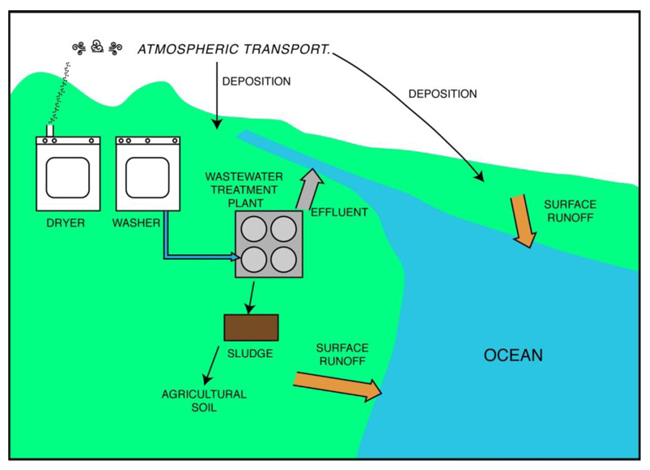
Schematic depicting simplified pathways of microplastics and nanoplastics leaked from laundry washers and dryers into oceans.
Developing sustainable and closed-loop solutions to reduce synthetic fibers, microplastics, and nanoplastics leakage from laundry systems into the marine environment
• Kathy Bunting-Howarth – NYSG's Associate Director
• Beizhan Yan – Lamont Doherty Earth Observatory of Columbia University
Thirty-five percent of microplastics passed into the environment are microfibers, whose major source are our clothes. Washing our clothes tends to shed these synthetic, environmentally harmful particles. The goal of this study is to stop the release of microplastics and nanoplastics (<1µm) (MP and NP) that eventually find their way into the sea. This project will deploy advanced filtration techniques in both commercial and residential laundry facilities. Researchers also aim to explore recycling of collected fibers by partnering with a leading textile fiber recycling company. Further project aims are to transfer the developed techniques to industry more widely.
Wastewater treatment plants are not currently set up to handle MP and NP particle removal. The use of suitable filtration techniques at the source point of laundry machines could offer a practical and immediate solution to stop MP and NP pollution.
“The overarching goal of this study is to plug the leak of microplastics and nanoplastics into our marine environments from domestic and commercial laundries,” said Beizhan Yan, Lamont Associate Research Professor at Lamont-Doherty Earth Observatory of Columbia University. “We aim to do this through the development of closed-loop solutions that utilize advanced ultrafiltration techniques and novel methods for reusing the filtered materials.”
“We’ve tested the quantity of MP and NP in laundry waste,” Yan added. “A preliminary calculation showed that each wash (about three pounds of clothes) releases approximately 30,000 microplastics (MPs) and 500,000 nanoplastics (NPs), respectively.”
The artificial root and laundry filtration projects in New York are two out of 10 Challenge competition awardees. Recipients of the awards include researchers with organizations from Alabama, Alaska, California, Hawai'i, Maine, Mississippi, New York and South Carolina. They were recommended for approximately $22 million in total funding. For more, see the full list of and descriptions for Marine Debris Challenge projects.
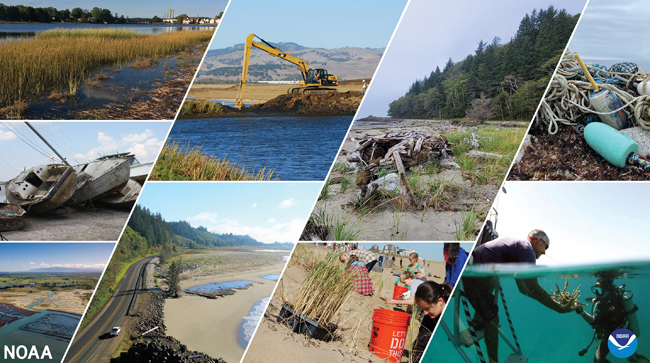
A photo collage of some of the projects being recommended for funding nationwide under the Bipartisan Infrastructure Law (BIL) and the Inflation Reduction Act (IRA). This includes $6.9 million for projects across New York, a number of which support marine debris studies involving NYSG. These projects will make communities and the economy more resilient to climate change.
Marine Debris Funding: National and Statewide Perspective
NOAA announced $562 million in recommended funding for nearly 150 projects across 30 coastal and Great Lakes states and territories to make communities and the economy more resilient to climate change. The awards are made under NOAA’s Climate-Ready Coasts Initiative and are funded by the Bipartisan Infrastructure Law and bolstered by the Inflation Reduction Act.
As a component of this funding, Sea Grant announced $27 million in projects that will address the prevention and removal of debris in marine and Great Lakes environments throughout the U.S.
New York Sea Grant’s three projects are among 29 competitively selected through two opportunities supported by the Bipartisan Infrastructure Law (BIL) and leveraging funds from the Inflation Reduction Act: The Marine Debris Challenge Competition and The Marine Debris Community Action Coalitions.
Using Sea Grant’s partnered approach to bring science together with communities for effective solutions, the projects will support transformational research and the creation of local coalitions to address urgent marine debris prevention and removal needs. All projects are designed to support the principles of justice, equity, diversity, inclusion, and accessibility as work is performed over the next three years.
This work is a component of nearly $3 billion in targeted investments for NOAA in the areas of habitat restoration, coastal resilience and weather forecasting infrastructure through the BIL to help America build resilience to climate change.
More Info: New York Sea Grant
New York Sea Grant (NYSG), a cooperative program of Cornell University
and the State University of New York (SUNY), is one of 34 university-based
programs under the National Oceanic and Atmospheric Administration’s
National Sea Grant College Program.
Since 1971, NYSG has represented a statewide network of integrated
research, education and extension services promoting coastal community
economic vitality, environmental sustainability and citizen awareness
and understanding about the State’s marine and Great Lakes resources.
Through NYSG’s efforts, the combined talents of university scientists
and extension specialists help develop and transfer science-based
information to many coastal user groups—businesses and industries,
federal, state and local government decision-makers and agency managers,
educators, the media and the interested public.
The program maintains Great Lakes offices at Cornell University, SUNY
Buffalo, SUNY Oswego and the Wayne County Cooperative Extension office
in Newark. In the State's marine waters, NYSG has offices at Stony Brook
University in Long Island, Brooklyn College and Cornell Cooperative
Extension in NYC and Kingston in the Hudson Valley.
For updates on Sea Grant activities: www.nyseagrant.org has RSS, Facebook, Twitter, Instagram, and YouTube links. NYSG offers a free e-list sign up via www.nyseagrant.org/nycoastlines for its flagship publication, NY Coastlines/Currents, which is published quarterly.